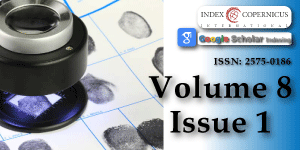Investigation of Stain Patterns from Diverse Blood Samples on Various Surfaces
Main Article Content
Abstract
Bloodstain Pattern Analysis (BPA) is a crucial forensic technique in crime scene investigation, employing the interpretation of blood spatter patterns to reconstruct event sequences and determine spatial relationships between victims and surfaces. This study explores BPA’s application in forensic science, emphasizing its role in establishing links between crimes and culprits, as posited by Edmond Locard’s exchange principle. The research examines how bloodstain shape, size, and distribution reveal critical information about impact angles, areas of convergence, and points of origin, while also providing insights into blood flow direction, force applied, suspect positioning, and weapons used. The investigation delves into various bloodstain types, including void patterns, spikes, and satellite stains, and their formation on different surfaces. To enhance understanding of blood behaviour from various sources, the study compares blood samples from three species: human (Homo sapiens), obtained from a professional doctor from discarded piles with precaution from a government hospital in Laxmangarh, Rajasthan and goat (Capra aegagrus hircus), and chicken (Gallus gallus domesticus), obtained from butcher shops in Laxmangarh, Rajasthan. The experimental setup involves dropping blood from a height of 50 centimetre’s and measuring the resulting stain dimensions. This comprehensive approach to BPA research aims to refine crime scene analysis techniques, ultimately contributing to more accurate event reconstructions and enhanced forensic investigations. The study underscores the importance of BPA in modern forensic science while acknowledging the need for its integration with other investigative methods to ensure robust and reliable crime scene interpretations.
Article Details
Copyright (c) 2024 Rajkumari S

This work is licensed under a Creative Commons Attribution 4.0 International License.
Pitrowski E. Über Entstehung Form, Direction and spread of traces of blood after slashing wounds to the head. Elmira Heights: Golos Printing. 1895; 8.
Hulse Smith L, Mehdizadeh NZ, Chandra S. Deducing drop size and impact velocity from circular bloodstains. J Forensic Sci. 2005;50(1):54-63. Available from: https://pubmed.ncbi.nlm.nih.gov/15830997/
Bevel T, Gardner RM. Bloodstain pattern analysis with an introduction to crime scene reconstruction. 2nd ed. Boca Raton: CRC Press; 2008. Available from: https://doi.org/10.1201/9781420052725
James S, Kish P, Sutton T. Principles of bloodstain analysis. Boca Raton: CRC Press; 2005. Available from: https://doi.org/10.1201/9781420039467
Peschel O, Kunz SN, Rothschild MA, Mutzel E. Bloodstain pattern analysis. Forensic Sci Med Pathol. 2011;7(3):257-270. Available from: https://doi.org/10.1007/s12024-010-9198-1
Adrian W, Adrian L. Bloodstain pattern analysis. In: Fraser J, Williams R, editors. Handbook of forensic science. Devon: William Publishing; 2009; 229-231.
Swgstain S. Scientific Working Group on Bloodstain Pattern Analysis. Recommended terminology. Forensic Sci Commun. 2009;11(2):1-7. Available from: http://theiai.org/docs/SWGSTAIN_Terminology.pdf
Attinger D, Moore C, Donaldson A, Jafari A, Stone H. Fluid dynamics topics in bloodstain pattern analysis: Comparative review and research opportunities. Forensic Sci Int. 2013;231(1-3):375-396. Available from: https://doi.org/10.1016/j.forsciint.2013.04.018
White B. Bloodstain patterns on fabrics: The effect of drop volume, dropping height and impact angle. J Can Soc Forensic Sci. 1986;19(1):3-36. Available from: https://doi.org/10.1080/00085030.1986.10757399





